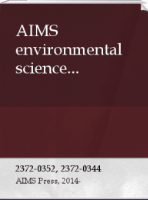
AIMS Environmental Science
Scope & Guideline
Unveiling Cutting-Edge Research in Environmental Science
Introduction
Aims and Scopes
- Environmental Impact Assessment:
The journal emphasizes studies that assess the environmental impact of various activities and technologies, utilizing methods such as life cycle analysis, predictive modeling, and ecological assessments. - Sustainable Resource Management:
Research on sustainable management practices for natural resources, including water, soil, and waste, is a core area, highlighting techniques for enhancing resource efficiency and minimizing waste. - Technological Innovations in Environmental Science:
AIMS Environmental Science showcases advancements in technology, including artificial intelligence, machine learning, and smart technologies, to address environmental challenges and improve sustainability. - Climate Change and Mitigation Strategies:
The journal covers research related to climate change, including mitigation strategies, carbon emissions reduction, and the evaluation of policies aimed at achieving sustainability goals. - Ecological and Health Risk Assessments:
A focus on assessing the risks associated with environmental pollutants and their impact on human health and ecosystems, utilizing advanced statistical and modeling techniques.
Trending and Emerging
- Artificial Intelligence and Machine Learning Applications:
An increasing number of studies are utilizing AI and machine learning techniques to enhance environmental monitoring, prediction, and decision-making, showcasing the integration of technology in environmental science. - Circular Economy and Sustainable Supply Chains:
Research exploring circular economy principles and sustainable supply chain management is gaining traction, indicating a shift towards more sustainable production and consumption practices. - Bioremediation and Waste Valorization:
There is a notable rise in studies focused on bioremediation techniques and the valorization of waste materials, highlighting innovative approaches to waste management and environmental restoration. - Climate Resilience and Adaptation Strategies:
Emerging themes include strategies for enhancing climate resilience and adaptation, addressing the urgent need for communities and ecosystems to adapt to changing environmental conditions. - Interdisciplinary Approaches to Environmental Challenges:
The journal is increasingly publishing interdisciplinary research that combines insights from various fields, such as economics, sociology, and environmental science, to tackle complex environmental issues.
Declining or Waning
- Traditional Pollution Studies:
Research focused solely on traditional pollution types, such as air and water pollution without integrating modern methodologies or addressing the broader implications of pollution, has become less frequent. - Single-Factor Analysis in Environmental Studies:
There is a noticeable decrease in studies that analyze environmental problems from a single-factor perspective, as the field moves towards more integrated, multi-faceted approaches. - Historical Environmental Assessments:
Papers centered on historical environmental assessments without contemporary relevance or implications have waned, reflecting a shift towards real-time data and current environmental challenges.
Similar Journals
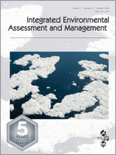
Integrated Environmental Assessment and Management
Transforming environmental challenges into actionable knowledge.Integrated Environmental Assessment and Management, published by Wiley, stands at the forefront of interdisciplinary research in the fields of environmental science and geography. With an impact factor reflective of its significant contribution to the academic community, this journal is categorized as Q2 in Environmental Science, Q1 in Geography, Planning and Development, and Q2 in Medicine as of 2023. Covering a broad spectrum of topics, it facilitates the integration of assessment and management practices crucial to addressing contemporary environmental challenges. As of the convergence years from 2005 to 2024, the journal has consolidated its reputation, holding notable ranks in Scopus, including #121 in the Social Sciences—Geography, Planning and Development category and #62 in General Environmental Science. While this journal does not currently operate under an open access model, it remains an essential resource for researchers, professionals, and students who seek to enhance their understanding of environmental and geographical issues through rigorous scientific inquiry.
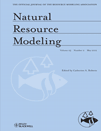
NATURAL RESOURCE MODELING
Pioneering insights for a sustainable future in natural resource modeling.NATURAL RESOURCE MODELING is a prestigious academic journal published by Wiley, focusing on the critical intersection of environmental science and modeling and simulation techniques. With an ISSN of 0890-8575 and an E-ISSN of 1939-7445, the journal has established itself as a vital resource for scholars and practitioners since its inception in 1990. Covering a wide array of topics related to the sustainable management and modeling of natural resources, the journal currently holds a reputable Q2 ranking in Environmental Science and a Q3 ranking in Modeling and Simulation, highlighting its impact within these fields, particularly with Scopus rankings placing it in the 60th and 57th percentiles, respectively. Although not an Open Access journal, it offers researchers, professionals, and students invaluable insights and methodologies pertinent to advancing the knowledge base in environmental management. The journal's commitment to high-quality research and its comprehensive scope reinforce its importance as a go-to publication for anyone interested in the sustainable future of our natural resources.

Acta Scientiarum Polonorum-Formatio Circumiectus
Transforming ecological research into actionable strategies.Acta Scientiarum Polonorum-Formatio Circumiectus is a distinguished open-access journal published by WYDAWNICTWO UNIWERSYTETU ROLNICZEGO HUGONA KOLLATAJA KRAKOWIE, dedicated to advancing knowledge in the fields of ecological modeling, environmental engineering, nature and landscape conservation, and water science and technology. With a commitment to accessibility since its inception in 2006, this journal provides a platform for researchers, professionals, and educators to disseminate their findings to a global audience. Although currently categorized in the Q4 quartile across various ecological disciplines, the journal's aim is to foster critical discussions and innovative approaches to pressing environmental challenges. The journal is based in Poland, and its scope encompasses a wide array of research areas pertinent to contemporary environmental studies. Acta Scientiarum Polonorum serves as an essential resource in its field, encouraging empirical research and theoretical advancements that collectively contribute to sustainable development and environmental stewardship.
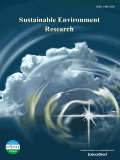
Sustainable Environment Research
Driving impactful discussions on environmental sustainability.Sustainable Environment Research, an esteemed journal published by BMC, serves as a pivotal platform for disseminating innovative research in the fields of Environmental Engineering, Pollution, and Renewable Energy. Established in 2016 as an Open Access journal, it facilitates the widespread sharing of knowledge and advancements across the globe, reflecting its commitment to enhancing environmental sustainability. With an impressive Q1 ranking in multiple categories, including Water Science and Technology and Pollution, the journal is recognized for its significant impact, currently holding a rank of 31st in Environmental Science - Water Science and Technology. The journal actively invites researchers, professionals, and students to contribute to crucial discussions around sustainable practices and technologies, thus addressing worldwide environmental challenges. Based in Taiwan but accessible internationally, Sustainable Environment Research provides a valuable resource for those dedicated to advancing the science of sustainability.

Hydrology Research
Connecting researchers for impactful hydrology discoveries.Hydrology Research, a leading academic journal published by IWA Publishing, is dedicated to advancing the field of water science and technology. With an impressive impact factor and a Q2 ranking in its category, the journal plays a pivotal role in disseminating innovative research and practices in hydrology. Established in 1973 and transitioning to an Open Access model in 2020, it provides unrestricted access to high-quality articles that cover a broad spectrum of topics, including hydrological processes, water management, and environmental impact assessments. Situated in Denmark, Hydrology Research continues to thrive as an essential platform for researchers, professionals, and students alike, encouraging the exchange of ideas that contribute to sustainable water solutions worldwide. With a comprehensive coverage of research converging from 1973 to 2024, it stands as a testament to ongoing progress in the water science community.
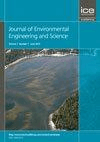
Journal of Environmental Engineering and Science
Pioneering Research for a Greener PlanetJournal of Environmental Engineering and Science, published by Emerald Group Publishing Ltd, is a prominent academic platform dedicated to the dissemination of cutting-edge research in the fields of environmental engineering, chemistry, and science. This journal, with ISSN 1496-2551 and E-ISSN 1496-256X, features a comprehensive collection of studies that delve into innovative methodologies and practical applications aimed at solving pressing environmental issues. Having been published since 2002, it spans critical research years from 2015 to 2024, offering insights that are invaluable to both academics and practitioners alike. With its current rankings placing it in the fourth quartile for Environmental Chemistry and Engineering, and the third quartile in miscellaneous Environmental Science, the journal serves as a significant yet under-utilized resource for emerging scholars seeking to contribute to the ecological discourse. Though it does not offer Open Access, the content is meticulously curated to uphold academic rigor, catering especially to researchers, professionals, and students keen on advancing their understanding of environmental challenges and engineering solutions.

ENVIRONMENTAL SCIENCE AND POLLUTION RESEARCH
Advancing the Frontiers of Environmental KnowledgeEnvironmental Science and Pollution Research is a premier international journal published by Springer Heidelberg, dedicated to advancing knowledge in the field of environmental science and pollution. With an impressive impact factor reflecting its vital contributions to research, the journal is categorized in the top quartiles (Q1 and Q2) across several domains, including Health, Toxicology and Mutagenesis, and Environmental Chemistry. Established in 1994, it continues to be a critical resource for researchers, professionals, and students focusing on pressing environmental issues. The journal provides an insightful platform for disseminating significant findings related to pollution and its effects on health and the environment, contributing to a better understanding and resolution of these challenges. While it currently does not offer Open Access options, its inclusion in prominent rankings, such as the Scopus rankings, underscores its reputation and influence within the scientific community.
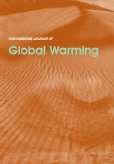
International Journal of Global Warming
Illuminating the Path to Environmental SustainabilityWelcome to the International Journal of Global Warming, a pioneering publication dedicated to advancing knowledge in the crucial fields of global warming, climate change, and environmental policy. Published by INDERSCIENCE ENTERPRISES LTD, this journal serves as an essential platform for interdisciplinary research, examining the multifaceted impacts of global temperature rises on our planet. Since its inception in 2009 and continuing through to 2024, the journal has fostered a vibrant scholarly community, despite currently being indexed in the Q4 quartile for Atmospheric Science and Global and Planetary Change. The journal's unique focus allows researchers, professionals, and students to engage with critical data and innovative methodologies in environmental management, monitoring, and legal policy responses. Submissions are invited from scholars worldwide, though the journal is not open access, ensuring a selective and quality-driven publication process. Beyond its academic contributions, the International Journal of Global Warming plays a significant role in shaping discussions about climate resilience and sustainability practices, making it a vital resource in today's pressing environmental discourse.

Environmental Processes-An International Journal
Exploring Interdisciplinary Insights in Environmental ScienceEnvironmental Processes-An International Journal, published by SPRINGER INT PUBL AG, serves as a vital platform for researchers and professionals dedicated to the dynamic field of environmental science. Established in 2014, this journal has rapidly gained prominence, currently holding a commendable Impact Factor and achieving impressive Scopus Rankings across various categories, including Q1 status in Water Science and Technology and Q2 in areas such as Environmental Engineering and Health, Toxicology and Mutagenesis. The journal emphasizes innovative research that contributes to the understanding and management of environmental processes and policies, addressing urgent challenges facing our planet. With a focus on high-quality, peer-reviewed content, Environmental Processes invites contributions that explore interdisciplinary approaches, making it a critical resource for scholars, policy-makers, and students invested in fostering a sustainable future through rigorous scientific inquiry. Access options are available for diverse readership, ensuring that essential findings are disseminated widely to inform decision-making and cultivate impact.

GLOBAL JOURNAL OF ENVIRONMENTAL SCIENCE AND MANAGEMENT-GJESM
Fostering collaboration for a greener planet.Global Journal of Environmental Science and Management (GJESM), published under the distinguished leadership of Professor J. Nouri, is an esteemed academic platform dedicated to advancing the interdisciplinary discourse surrounding environmental science and management. With an ISSN of 2383-3572 and an E-ISSN of 2383-3866, GJESM has established itself as a prominent Open Access journal since 2014, allowing for unrestricted sharing of knowledge and research findings. Based in Iran, this journal caters to a diverse global audience, featuring contributions that span various critical domains including agricultural and biological sciences, environmental engineering, pollution management, and social sciences, evidenced by its impressive 2023 Q1 and Q2 quartile rankings across multiple categories. The journal’s Scopus rankings demonstrate a robust standing in the academic landscape, with exciting placements that underscore its relevance in key fields. By bridging the gap between scientific inquiry and practical application, GJESM serves as a vital resource for researchers, practitioners, and students seeking to understand and address the pressing environmental challenges faced by our planet today.